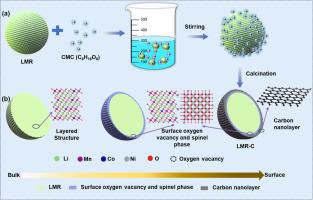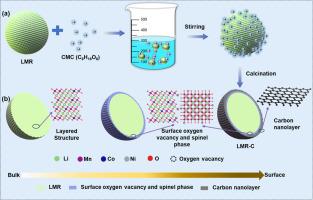Enhancing structural integrity and performance of Li-Rich Mn-based cathode materials via multi-component surface engineering
IF 5.6
3区 材料科学
Q1 ELECTROCHEMISTRY
引用次数: 0
Abstract
High energy density Li-rich Mn-based cathode materials (LMR) are the research hotspot of cathode materials for new generation of Li-ion batteries. Unlike the conventional cationic oxidation/reduction reaction mechanism, the ultrahigh specific capacity of this material primarily stems from the participation of partial lattice oxygen in the electrochemical reaction. However, the accompanying irreversible oxygen release can lead to structural transformation and interfacial side reactions, thereby accelerating voltage and capacity decay. Therefore, we constructed a surface multicomponent integration strategy integrating oxygen vacancies, spinel/layered heterostructures, and carbon nano-coatings through a scalable carboxymethyl cellulose (CMC)-assisted interfacial engineering strategy. This surface multi-component modified layer is perfectly compatible with the main structure, effectively stabilizes the surface structure, avoids direct contact between the main structure of the material and the electrolyte, reduces side reactions between the electrode surface and the electrolyte, inhibits the formation of the inert cathode electrolyte interface (CEI), and reduces the dissolution of the transition metal ions during the cycling. In addition, spinel phases with 3D Li-ion diffusion channels and carbon nano-coatings with fast electron conduction paths effectively improve the electronic and ionic conductivity of the electrode material surface. Electrochemical performance tests show that the initial coulombic efficiency of the surface-modified material is increased from 72.6 % to 86.2 %, and the capacity retention is 80.7 % after 300 cycles at 1 C rate, and the rate performance is also significantly improved, which indicates that this surface multicomponent integration strategy effectively improves the comprehensive electrochemical performance of the material.


多组分表面工程提高富锂锰基正极材料的结构完整性和性能
高能量密度富锂锰基正极材料是新一代锂离子电池正极材料的研究热点。与传统的阳离子氧化还原反应机理不同,该材料的超高比容量主要源于部分晶格氧参与了电化学反应。然而,伴随的不可逆氧释放会导致结构转变和界面副反应,从而加速电压和容量的衰减。因此,我们通过可扩展的羧甲基纤维素(CMC)辅助界面工程策略构建了一种集成氧空位、尖晶石/层状异质结构和碳纳米涂层的表面多组分集成策略。这种表面多组分修饰层与主体结构完美兼容,有效稳定了表面结构,避免了材料主体结构与电解质的直接接触,减少了电极表面与电解质之间的副反应,抑制了惰性阴极电解质界面(CEI)的形成,减少了循环过程中过渡金属离子的溶解。此外,具有3D li离子扩散通道的尖晶石相和具有快速电子传导路径的碳纳米涂层有效地提高了电极材料表面的电子和离子电导率。电化学性能测试表明,表面改性材料的初始库仑效率从72.6%提高到86.2%,在1℃速率下循环300次后容量保持率为80.7%,速率性能也有显著提高,表明该表面多组分集成策略有效提高了材料的综合电化学性能。
本文章由计算机程序翻译,如有差异,请以英文原文为准。
求助全文
约1分钟内获得全文
求助全文
来源期刊

Electrochimica Acta
工程技术-电化学
CiteScore
11.30
自引率
6.10%
发文量
1634
审稿时长
41 days
期刊介绍:
Electrochimica Acta is an international journal. It is intended for the publication of both original work and reviews in the field of electrochemistry. Electrochemistry should be interpreted to mean any of the research fields covered by the Divisions of the International Society of Electrochemistry listed below, as well as emerging scientific domains covered by ISE New Topics Committee.
 求助内容:
求助内容: 应助结果提醒方式:
应助结果提醒方式:


